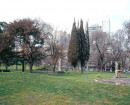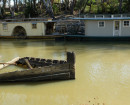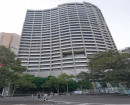Smythesdale Precinct
Glenelg Highway SMYTHESDALE, Golden Plains Shire
-
Add to tour
You must log in to do that.
-
Share
-
Shortlist place
You must log in to do that.
- Download report


Statement of Significance
What is Significant?
Smythesdale is located on the Glenelg Highway, about 20 kms south-west of Ballarat on generally level ground north-east of the Woady Yalloak River. While gold had been discovered throughout the Woady Yalloak district, it was the rush to Smythe's and Brown's Diggings which established the town of Smythesdale in 1855 and its consolidation as the colonial government's administration. The complex of Courthouse, Police Station and Police Stables, including the trees surviving from the Police Magistrate's garden, is one of the best surviving in the central goldfields. The heyday of the town was in the 1860s and 1870s. The township's street grids show an attempt to control its naturally organic linear form. The main public buildings were always located close to the intersection of Brooke Street and Heales Street. The former di-chromatic brick Post Office, the painted brick Smythesdale Hotel and the rendered Masonic Hall are each important contributors to the streetscape because of their distinctive architecture and historic functions. The retreat house built by the Masons opposite their hall may be the only such example in Victoria. These buildings, while conventional in their form and typical in their style, are more pretentious in their scale than similar buildings in nearby towns. The Mechanic Institute hall survives. One bank and several cottages in clusters survive along the main street. One shop survives but with very low integrity. None of the three churches survives on its original site. The Railway Station was in Ireland Street but nothing survives. The redundancy and loss of so many public and private buildings illustrates the great decline of the gold fields' townships.
How is it Significant?
The township of Smythesdale is of historical, architectural and social significance to the Golden Plains Shire.
Why is it Significant?
The township of Smythesdale is of historical significance as one of the many small settlements in the Shire established on the site of gold rushes in the 1850s and 1860s, several of which have survived into the twenty-first century. It was the administrative centre for the colonial government imposing law and order as well as controls on the mining industry. It is of architectural significance for its range of very modest private buildings dating from the nineteenth century and several particularly fine public buildings, the most important of which are the former Post Office, the former Courthouse and Police complex. The Courthouse Hotel is particularly distinctive for its rare form and dominant siting. The Masonic Hall and the residence opposite, built by the Masons, create a special relationship. These and other buildings are complimented by mature trees, as well as the limited surviving civic infrastructure. The township is of social significance for its survival from a peak of many thousands, reflected in some surviving public buildings and cottages, to their modern population of less than one and a half thousand in the whole district. The township reflects the inter-relationship between pastoral, mining and agricultural pursuits.
-
-
Smythesdale Precinct - Physical Description 1
The township of Smythesdale is located on the Glenelg Highway about 20 kms south-west of Ballarat. The highway runs diagonally through the town. The topography is relatively flat. The land is generally subdivided into regular town allotments but these are adjusted to accommodate the direction of the main road, which is called Brooke Street.
The Smythesdale Heritage Precinct is located on either side of Brooke Street, bound to the north by Heales Street and to the south by Verdon Street. On the north-east side the town begins with a group of public buildings, the first being the former courthouse, police station, lock-up and police stables. Each of these follows a more or less standard Public Works Department design for its type. The most distinctive is the Court House with its enclosed verandah. These buildings are each substantially intact, retain a high degree of integrity and are in good condition. This complex once included the police magistrate's residence and garden, on the corner of Heales and Ireland Streets. The mature exotic plantings which survive include: Quercus robur x 3 (English Oak); Cupressus macrocarpa (Monterey Cypress); Cedrus deodara (Deodar Cedar); Ilex spp. x 2 (Holly); Arbutus unedo (Irish Strawberry Tree); Crataegus spp. X 3 including laevigatum (Hawthorn); Robinia pseudoacacia (Black Locust); Araucaria bidwillii (Bunya Bunya Pine); and Araucaria cunninghamii (Hoop Pine) which is in very poor condition. There are other exotic shrubs and ground covers which now have the status of weeds.
Dominating this entrance to the town is the Courthouse Hotel (63 Brooke Street). Only the second historic section, the late 1860s two-storey brick extension on the street boundary survives, the original 1850s single storey timber section having been demolished and replaced in 2008. It has a very rare cantilevered balcony, actually a reconstruction of the original, at first floor with a distinctive criss-cross balustrade and French doors opening onto it. Further along Brooke Street is the Masonic Lodge, a small by finely detailed neo-Classical building which reflects the values and associations of Freemasonry. It has been compromised by the bricking up of its front door and the substantial reduction of the front windows. Opposite is a red and clinker brick residence with a terra cotta tile roof, built by the Masons as a holiday retreat. It takes the form of a substantial Interwar bungalow and has a distinctive fence, gates and portals (not all still on the original title). The densely planted garden makes a substantial contribution to the streetscape. The adjacent houses were moved in. This section of Brooke Street concludes with the former Post Office (50 Brooke Street). This is a particularly distinguished building which uses the Italianate style to combine its official function on the ground floor and its domestic function on the upper floor. It is also a very early and rare example of the use of di-chromatic brickwork by the Public Works Department. The arcaded verandah is a very strong feature as is the original entrance on the east side. It is substantially intact, retains are high degree of integrity and is in very good condition. Loader Street includes several important Quercus robur (English Oak) in an incomplete avenue on both sides of the Highway. The further section of Brooke Street includes early vernacular cottages and several shops, some of which have been compromised by inappropriate alterations, such as 34 Brooke Street. The former Union Bank survives at 42 Brooke Street. The building at 44 Brooke Street includes the Mechanics Institute hall although the verandah across the 1960s supper room is a modern addition. This section of the main street terminates with a distinctive residence at 17 Brooke Street, an austere two-storey house with limited di-chromatic brick details and a slate roof and no verandah or porch.
Smythesdale Precinct - Historical Australian Themes
Australian Historic Themes
The Australian Heritage Commission devised the Australian Historic Themes in 2001. The following themes have influenced the historical development of the Smythesdale Precinct.
2. Peopling Australia
2.2 Adapting to diverse environments
2.4 Migrating
2.4.2 Migrating to seek opportunity
2.4.5 Changing the face of rural and urban Australia through migration
2.5 Promoting settlement
3 Developing Local, Regional And National Economies
3.3 Surveying the continent
3.3.3 Prospecting for precious metals
3.3.5 Laying out boundaries
3.4 Utilising natural resources
3.4.3 Mining
3.6 Recruiting labour
3.7 Establishing communications
3.7.1 Establishing postal services
3.8 Moving goods and people
3.8.5 Moving goods and people on land
3.8.6 Building and maintaining railways
3.8.7 Building and maintaining roads
3.12 Feeding people
3.12.2 Developing sources of fresh local produce
3.12.5 Retailing foods and beverages
4 Building Settlements Towns And Cities
4.1 Planning urban settlements
4.1.1 Selecting township sites
4.2 Supplying urban services (power, transport, fire prevention, roads, water, light and sewerage)
4.3 Developing institutions
4.5 Making settlements to serve rural Australia
4.6 Remembering significant phases in the development of settlements, towns and cities
5 Working
5.1 Working in harsh conditions
5.1.2 Coping with dangerous jobs and workplaces
5.6 Working in the home
5.8 Working on the land
6 Educating
6.2 Establishing schools
7 Governing
7.6 Administering Australia
7.6.1 Developing local government authorities
7.6.3 Policing Australia
7.6.4 Dispensing justice
7.6.5 Incarcerating people
7.6.12 Conserving Australia's heritage
8 Developing Australia's Cultural Life
8.6 Worshipping
8.6.1 Worshipping together
8.6.2 Maintaining religious traditions and ceremonies
8.6.4 Making places for worship
8.5 Forming associations
8.7 Honouring achievement
8.8 Remembering the fallen
8.12 Living in and around Australian homes
8.14 Living in the country and rural settlements
Smythesdale Precinct - Physical Description 2
Contributory elements located in the proposed Smythesdale Heritage Precinct:
Milestones, Brooke Street Smythesdale
House, 17 Brooke Street Smythesdale
House, 25 Brooke Street Smythesdale
House, 26 Brooke Street Smythesdale
House, 27 Brooke Street Smythesdale
House (Former Shop), 34 Brooke Street Smythesdale
Shop, 42 Brooke Street Smythesdale
Former Mechanics Institute, 44 Brooke Street Smythesdale
House, 46 Brooke Street Smythesdale
House, 48 Brooke Street Smythesdale
Bungalow House, 49 Brooke Street Smythesdale
Former Post Office, 50 Brooke Street Smythesdale
Federation/Edwardian Weatherboard House, 51 Brooke Street Smythesdale
Drinking Fountain & Plaque, 52 Brooke Street Smythesdale
Masonic Hall, 54 Brooke Street Smythesdale
Former Masonic Residence, 55 Brooke Street Smythesdale
Smythesdale Precinct - Integrity
The township ofSmythesdale remains substantially intact and the surviving buildings and infrastructure from a range of periods retain from a good to a high degree of integrity. Key public buildings and surviving examples of commercial and residential development provide a clear sense of past and present settlement.
Heritage Study and Grading
Golden Plains - Golden Plains Shire Heritage Study Phase 2
Author: Heritage Matters P/L
Year: 2009
Grading: Local
-
-
-
-
-
ARGYLE HILL
 Victorian Heritage Inventory
Victorian Heritage Inventory -
CAXTON CO
 Victorian Heritage Inventory
Victorian Heritage Inventory -
ROXBURGH CO.
 Victorian Heritage Inventory
Victorian Heritage Inventory
-
-






